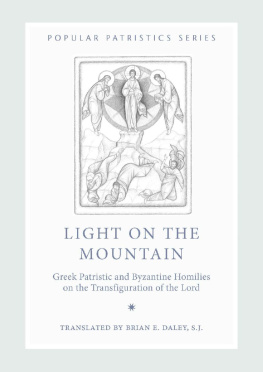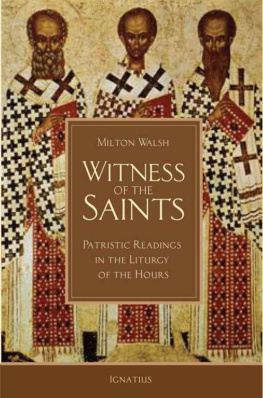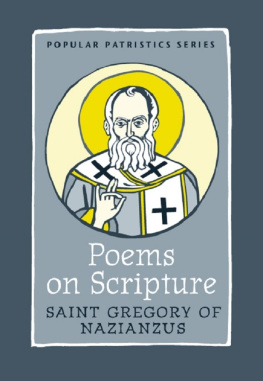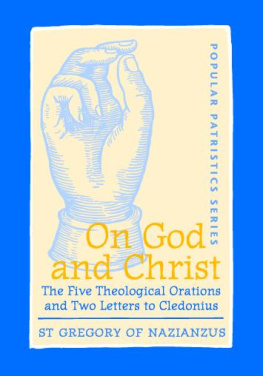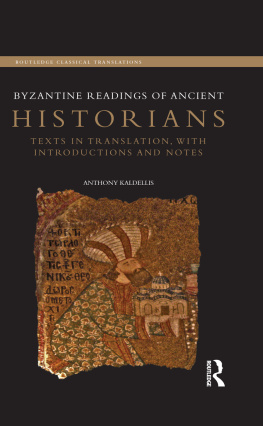Brian E. Daley - Light on the Mountain: Greek Patristic and Byzantine Homilies on the Transfiguration of the Lord (Popular Patristics Series Book 48)
Here you can read online Brian E. Daley - Light on the Mountain: Greek Patristic and Byzantine Homilies on the Transfiguration of the Lord (Popular Patristics Series Book 48) full text of the book (entire story) in english for free. Download pdf and epub, get meaning, cover and reviews about this ebook. year: 2020, publisher: Saint Vladimirs Seminary Press, genre: Religion. Description of the work, (preface) as well as reviews are available. Best literature library LitArk.com created for fans of good reading and offers a wide selection of genres:
Romance novel
Science fiction
Adventure
Detective
Science
History
Home and family
Prose
Art
Politics
Computer
Non-fiction
Religion
Business
Children
Humor
Choose a favorite category and find really read worthwhile books. Enjoy immersion in the world of imagination, feel the emotions of the characters or learn something new for yourself, make an fascinating discovery.
- Book:Light on the Mountain: Greek Patristic and Byzantine Homilies on the Transfiguration of the Lord (Popular Patristics Series Book 48)
- Author:
- Publisher:Saint Vladimirs Seminary Press
- Genre:
- Year:2020
- Rating:3 / 5
- Favourites:Add to favourites
- Your mark:
- 60
- 1
- 2
- 3
- 4
- 5
Light on the Mountain: Greek Patristic and Byzantine Homilies on the Transfiguration of the Lord (Popular Patristics Series Book 48): summary, description and annotation
We offer to read an annotation, description, summary or preface (depends on what the author of the book "Light on the Mountain: Greek Patristic and Byzantine Homilies on the Transfiguration of the Lord (Popular Patristics Series Book 48)" wrote himself). If you haven't found the necessary information about the book — write in the comments, we will try to find it.
Brian E. Daley: author's other books
Who wrote Light on the Mountain: Greek Patristic and Byzantine Homilies on the Transfiguration of the Lord (Popular Patristics Series Book 48)? Find out the surname, the name of the author of the book and a list of all author's works by series.
Light on the Mountain: Greek Patristic and Byzantine Homilies on the Transfiguration of the Lord (Popular Patristics Series Book 48) — read online for free the complete book (whole text) full work
Below is the text of the book, divided by pages. System saving the place of the last page read, allows you to conveniently read the book "Light on the Mountain: Greek Patristic and Byzantine Homilies on the Transfiguration of the Lord (Popular Patristics Series Book 48)" online for free, without having to search again every time where you left off. Put a bookmark, and you can go to the page where you finished reading at any time.
Font size:
Interval:
Bookmark:
L ight on
the M ountain
greek patristic and byzantine homilies on the transfiguration of the lord
Translated by
Brian E. Daley, SJ
st vladimirs seminary press
yonkers, new york
Popular Patristics Series
Number
The Popular Patristics Series published by St Vladimirs Seminary Press provides readable and accurate translations of a wide range of early Christian literature to a wide audiencestudents of Christian history to lay Christians reading for spiritual benefit. Recognized scholars in their fields provide short but comprehensive and clear introductions to the material. The texts include classics of Christian literature, thematic volumes, collections of homilies, letters on spiritual counsel, and poetical works from a variety of geographical contexts and historical backgrounds. The mission of the series is to mine the riches of the early Church and to make these treasures available to all.
Series Editor
John Behr
Associate Editor
Augustine Casiday

copyright 2013 by
st vladimirs seminary press
575 Scarsdale Road, Yonkers, NY 10707
1-800-204-2665
www.svspress.com
isbn 978-0-88141-465-3
issn 1555-5755
All Rights Reserved
For my fellow members,
past and present,
of the North American
Orthodox-Catholic Consultation
(Psalm 36.9)
And after six days Jesus took with him Peter and James and John, and led them up a high mountain apart by themselves; and he was transfigured before them, and his garments became glistening, intensely white, as no fuller on earth could bleach them. And there appeared to them Elijah with Moses; and they were talking to Jesus. And Peter said to Jesus, Master, it is well that we are here; let us make three booths, one for you and one for Moses and one for Elijah. For he did not know what to say, for they were exceedingly afraid. And a cloud overshadowed them, and a voice came out of the cloud, This is my beloved Son; listen to him. And suddenly looking around they no longer saw anyone with them but Jesus only.
Mark 9.28
A number of summers ago, I spent a weekend as a guest at the monastery of Chevetogne, in southern Belgiumthe famous Catholic Benedictine community devoted to promoting mutual understanding and reconciliation between Orthodox and Catholic Christians. Since its foundation in 1925, this unique monastic community has, among other activities, devoted itself to celebrating the sacred liturgy and the divine office each day in both the Eastern and the Western forms, each regime of prayer attended on normal days by approximately half the monastic community. The rationale for this is the conviction that the most important way to work towards the reunion of the Churches is not simply to talk and study, to run conferences and to practice hospitality, but to pray daily in both liturgical traditions, as a single community of faith.
It was early August, and I was seated next to the Prior for the Sunday evening meal. He asked me how long I planned to stay, and when I told him that I was thinking of leaving the next day, he seemed surprised: Then you are not going to stay for the feast? he asked. I looked blankly at him, and he explained, Tuesday, of coursethe Feast of the Transfiguration, August 6; one of the twelve great feasts of the liturgical year in the Eastern calendar! Of course, I said, not admitting that I had forgotten. And I decided then and there to stay an extra day and to join in the celebration: an unforgettable experience, as it turned out, with a solemn all-night vigil and a festive Eastern liturgy in the morning, repeatedly and movingly punctuated by the great apolytikon or dismissal verse for the feast, which prays, You have been transfigured on the mountain, Christ our God, to reveal your glory to your disciples... By the prayers of the Mother of God, let your eternal light shine also on us sinners... Giver of light, glory to you!
This feast has been solemnly celebrated on August 6 by the Western Church, as well, since early medieval times, and was placed on the universal Roman liturgical calendar by Pope Callistus III in 1456; yet for most Catholics, it attracts relatively little attention, compared with the other major liturgical events of the year, which celebrate Gospel events in the life of Jesus and of Mary his Mother. In the tradition of the Eastern Churches, on the other hand, the commemoration of Jesus Transfiguration continues to loom large, as an occasion to commemorate an incident that was understood by theologians and preachers throughout the early Christian tradition to provide an essential key for understanding who Jesus really is, and how his life, culminating in his death and resurrection, brings to fulfillment Gods saving work in history. In the Gospel context, the Mystery of the Transfiguration of the Lord might be thought of as the interpretive link between the beginning of Jesus mission, at his baptism in the Jordan, and the climax of that mission on Calvary. It is his crowning epiphany to his disciples, the confirmation of their incipient faith that he is the Promised One of Israel and Gods Beloved Son, revealed to them even as he set his face to journey towards Jerusalem (Luke 9.51). It stands, then, at the heart of what we call, in modern Western terms, Christology.
I. The Transfiguration Account in the Gospels. The importance of the Transfiguration episode stands out with special clarity in the Gospel of Mark. Most contemporary Biblical scholars take Marks Gospel to be slightly older than those of Mathew and Luke, which seem to use it as a textual basis, while adding their own material and their distinctive interpretive themes. One of the principal organ izing themes in Mark is the gradual discovery, by his fellow Jews and especially by his followers, of Jesus true identity as the unique Son of God, sent by the God of Israel to inaugurate his Kingdom on earth, even in the face of Jesus apparent failure, rejection, and crucifixion by the occupying Romans, with the collusion of the leaders of his own people.
So the opening verse of Mark identifies the purpose of the work, even as it identifies Jesus by now-familiar titles: The beginning of the Gospel of Jesus Christ, the Son of God (Mark 1.1). In the first several chapters, as Jesus early ministry of preaching and healing is narrated, his identity remains mysterious; people are amazed by the authority of his teaching and the power of his signs (e.g., 1.27; 4.41; 5.42). In fact, Jesus is concerned to prevent his reputation as a wonderworker from simply spreading by word of mouth (e.g., 1.43; 5.43), though his wishes are usually contravened. Only the demons who experience his power recognize that he is the Holy One of God (1.24; cf 1.34), Son of the Most High God (5.8). Eventually, at the end of the narrative, as Jesus hangs dead on the cross, with the label The King of the Jews ironically tacked over head (15.26), it is the nameless Roman centurionneither a Jew nor a disciplestanding at the scene, who affirms, without qualification or apparent motive, Truly, this man was a Son of God! (15.39)
In the Greek manuscripts, Marks Gospel ends in several different ways. Most of the longer versions seem mainly to incorporate summaries of the accounts of Jesus appearances to his disciples that appear in the three other canonical Gospels. The so-called short ending, contained in the Codex Sinaiticus and other ancient, authoritative New Testament manuscripts, and which many New Testament scholars today consider to be the most likely original ending, appears to stop its account of the discovery of his resurrection abruptly in mid-story. Mary Magdalene and two other women disciples go to Jesus tomb early in the morning of the first day of the week, find that it is empty, and encounter a young man in white, who informs them that Jesus has been raised, and will meet them and the disciples again in Galilee. Mark reports that at this point the women said nothing to anyone, for they were afraid. If this narrative does indeed constitute the original ending of Marks Gospel, then clearly the rest of the story of the disciples growth to full faith in Jesus and his saving work was not spelled out here. It remained to be toldafter the text had been readin the oral witness of the Apostles, as the conclusion of a process that had only haltingly begun in the Gospel narrative itself: the process of fully realizing what it means to see in Jesus, who had been crucified, Israels true Messiah and Gods Son. But the structure of Marks Gospel, and the carefully arranged details of the story, are clearly meant to suggest that that real faith in him was already available, in principle, for those who were able to understand the story fully.
Font size:
Interval:
Bookmark:
Similar books «Light on the Mountain: Greek Patristic and Byzantine Homilies on the Transfiguration of the Lord (Popular Patristics Series Book 48)»
Look at similar books to Light on the Mountain: Greek Patristic and Byzantine Homilies on the Transfiguration of the Lord (Popular Patristics Series Book 48). We have selected literature similar in name and meaning in the hope of providing readers with more options to find new, interesting, not yet read works.
Discussion, reviews of the book Light on the Mountain: Greek Patristic and Byzantine Homilies on the Transfiguration of the Lord (Popular Patristics Series Book 48) and just readers' own opinions. Leave your comments, write what you think about the work, its meaning or the main characters. Specify what exactly you liked and what you didn't like, and why you think so.

